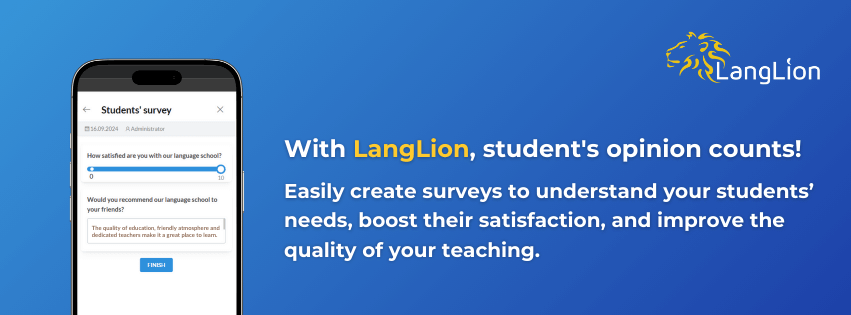
It’s often said that those who ask questions do not stray. Indeed, numerous questions appear daily in various Facebook groups and industry forums. And that’s great because sharing experiences with people from the same industry allows us to gain a new perspective on the challenges we face. However, there are some questions that, while answerable, are often misaddressed rather than unanswered.
Questions like, „I’m conducting marketing activities, but I lack clients. What am I doing wrong?” or „I’m receiving more course cancellations this year. I don’t know what’s happening.” are just a few examples. While you might receive some good advice, they often share one flaw – they tend to be general.
What will you find in this article?
- Is it worth conducting a student satisfaction survey?
- Why do students not continue their education?
- What questions to ask in a student satisfaction survey?
- When to conduct student satisfaction surveys?
- Key principles of creating a survey
- Summary – how to conduct a student satisfaction survey
Is it worth conducting a student satisfaction survey?
No one from the outside truly knows what’s really happening in your school and which areas of its operations require attention. The ones who know best what draws potential clients to your school and what repels them are… your students! It’s high time to ask them for their opinion.
If you want your business to operate at a high level and continuously develop, obtaining feedback from students is an absolutely fundamental action. Without a solid foundation, any further actions will not be effective in the long run.
The more data you gather, the easier it will be for you to analyze the weaknesses of the school and take appropriate steps to improve the quality of the services offered. You can also use the collected information to change the direction of communication and marketing activities so that potential clients become students at your school.
If you don’t have time for many activities, you can use the Net Promoter Score indicator. With NPS, how to survey customer satisfaction with a single indicator! One indicator, one question, tons of information!
Why do students not continue their education?
The results of conducted studies for at least 7 years are unambiguous: the vast majority of clients are willing to pay more for a service that offers better experiences. An increasing number of people realize that „time is money” is not just a cliché, but their daily reality.
Therefore, they choose courses that will actually bring them tangible benefits. The times when clients thought „I’ll sign up for a course because everyone is doing it and you need to know the language” are becoming a thing of the past.
At the same time, only 43% of clients are satisfied with their experiences with services and specific brands. This, in turn, is a cause of student turnover between schools.

What questions to ask in a student satisfaction survey?
Before we get into how to create a survey and how to share the form with your students, it’s worth first considering what information you want to obtain regarding your products and services.
Below, I will present you with examples of questions that you can easily tailor to your school, taking into account your sales process and the type of courses offered. Just remember not to cram everything into one survey.
Everyone will pale at the sight of a sheet with 25 questions that require more than a yes or no answer. It’s worth limiting their number to 10 and trying to make them clear and precise enough to obtain specific information.
Categories of questions to determine:
1. How the service is used?
Consider how your students use your services. This will help you better understand their needs and expectations.
Example questions:
- How often do you attend our classes?
- Do you use additional materials provided by our school?
- How did you learn about our courses?
2. Demographic data
It is worth verifying this information, especially if you run adult groups where the age range is the widest. It may also turn out that women are more satisfied with specific courses than men – this is valuable information. Although these are basic data, the correlation between gender and age with the level of course satisfaction can be not only surprising but also serve as an inspiration to create classes tailored to your target group.
Example questions:
- What is your educational background?
- What is your employment status?
- How old are you?
- Select your gender.
- How did you hear about our school?
The above questions are best provided with ready-made options to choose from.
3. Degree of satisfaction
These are questions where students rate their level of satisfaction on a scale (most often 5-point or 10-point). Thanks to them, you can easily derive an average score and understand, for example, that English courses at the B2 level were rated 7.5/10 in terms of teaching method, but their difficulty level was only rated 4/10. A specific numerical result allows for quick identification of areas requiring improvement, such as… Improper alignment of students’ levels with the group.
Example questions:
- How do you rate the difficulty level of the course?
- How satisfied are you with the way the classes are conducted?
- Would you recommend us to your friends/family?
- How do you rate our website in terms of ease of finding information?
- To what extent do you agree with the statement: I received all the necessary information before the course started?
It’s important to precisely define what each point on the scale means, e.g., 1 – very dissatisfied, 10 – very satisfied. To avoid confusion, you can use a star rating system (1-5) with the question „How many stars do you give your instructor?” and provide space below for justification of the answer. From experience, we know there have been instances where someone rated LangLion a 1, but in the comment mentioned that the platform is excellent and they can’t imagine learning without it.
4. Specific opinion
These are open-ended questions. Not all data can be obtained from closed-ended questions. If 60% of students state they are dissatisfied with the course, you don’t know why. The problem might be with the instructor, but it could just as well be that the classroom is too hot, making it hard to concentrate on learning.
Example questions:
- If you could change something about how classes are conducted, what would it be?
- What do you like the most about our courses?
- What teaching format is the most appealing to you?
- How would you rate the level of communication with the instructor/office?
- What could we do better?
If you want to learn more about this topic, read our post where we discuss surveys in language schools in detail!
When to conduct student satisfaction surveys?
There are two correct answers to this question: regularly and immediately after service delivery. For example, if you conducted a trial lesson, the survey should ideally reach the client the same day or no later than the next morning (if the class was held in the evening). Feedback provided within 24 hours is more accurate than feedback obtained later.
In the case of language courses, it’s worth giving students some time to form an opinion based on a few classes. In such situations, a good practice is to send a control survey after a month of learning, and another one after the end of the first semester.
If you want to measure student satisfaction and gather feedback on your school, use the LangLion Platform, which has a built-in survey module. You can create forms with single-choice and multiple-choice questions, open-ended and range questions.
With the E-learning module in LangLion, you can share surveys with specific individuals or groups, and if you need several similar forms, the system allows you to copy entire surveys. This saves time, which you can devote to other activities.

Key principles of creating a survey
Consistency – define one specific goal: evaluating a new website, the level of satisfaction with a course, or the quality of communication. Do not try to combine questions about different areas in one form.
Time – the ideal survey should take 5–10 minutes to avoid respondent fatigue.
Precision – one question = one topic. Do not combine different issues, e.g., „How do you rate the instructor and the classes they conduct?” These are two different matters.
Order of questions – start with the easiest ones so the respondent is more willing to proceed to the next ones. Place demographic questions at the end to avoid discouraging students at the start.
Welcome message – write a brief introduction where you explain the purpose of the research, the topic of the survey, and the estimated completion time. It’s also important to inform what the collected data will be used for.
Should the survey be anonymous?
In my opinion – definitely yes. Anonymity encourages students to share their feelings more freely. If they had to sign their opinions, it might lead them to alter reality – for example, out of fear of judgment or their responses reaching the instructor.
Summary – how to conduct a student satisfaction survey
A student satisfaction survey is a key tool for assessing the quality of courses at a language school. It’s best to conduct it regularly and after the course ends to gather fresh and relevant feedback.
A well-designed survey should be short, precise, with a clear purpose and questions about, among other things, the class level, relationship with the instructor, and the usefulness of materials. The anonymity of responses increases the honesty of the students, and the collected data helps improve the school’s offerings.
If you want to know more about this topic, read the article: how to measure and improve customer satisfaction in a language school!
